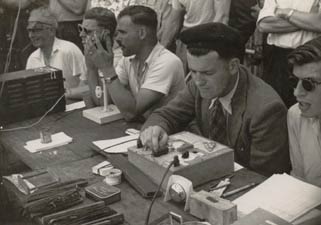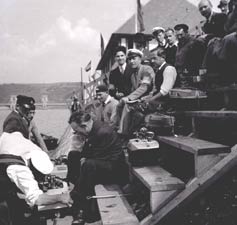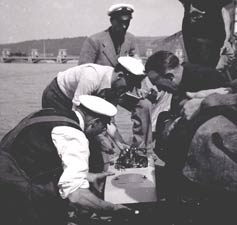

|
Home Updates Hydros Cars Engines Contacts Links Contact On The Wire ←Previous Next→ |
Edgar Westbury (con't)
The destruction of 'Beryl' left Westbury with an immediate problem. The International Regatta was due in three weeks time and it was his intention to run in the newly established ‘Miniature Class’ ‘to try and draw attention to its possibilities’, yet he had no suitable hull. Fortunately, Captain Bowden came to the rescue.
|
|
Bowden was a contemporary of Westbury's, and although more normally associated with model aircraft, had been spending an increasing amount of time working on tethered hydroplanes. Using model aircraft construction techniques, he had built a lightweight version of his ‘Jildi’ boat, which he naturally called ‘Jildi Junior’. The motor for this was a Westbury designed Atom Minor two-stroke that had been given some attention by Andrew Rankine from Ayr, who was the acknowledged master of the two-stroke at that time. This combination set a new ‘C Class’ record of 25mph in 1934. |
|
Bowden had an unused ‘Jildi Junior’ style hull, which he offered to Westbury as a stopgap that became ‘Beryl II’. Rather than the frame and stringer construction that Bowden had used on his record-breaking version, this one was carved from solid pine. As can be imagined, shoehorning a relatively large and heavy four stroke into a boat designed for an Atom Minor without major alteration to the hull proved difficult. |
|
Even though he managed to get the shaft lined up, it left the boat very top heavy with a propensity for capsizing when released due to torque reaction from the prop and the high C of G. Westbury realised that it needed some form of throttle control, which was appearing on several boats, but had no time to fit one before the regatta. In the event, he beat Bowden and ‘Jildi Junior’ by a small margin to win the Miniature Speed Championship at 21.2mph. Westbury also won the 15cc class at the Farnborough regatta the following month at a similar speed. The 21.2mph was the fastest recorded that season, giving ETW third place in the ME Speedboat competition B Class behind the flash steamer ‘Tornado II’ of Bert Martin and David Innes’ IC engined ‘Satellite’.
|
At the Wicksteed regatta in August 1935, Westbury and ‘Beryl’ was the only 15cc boat to turn up, so he gave an exhibition run at around 20mph, prompting the comment from John French that this ‘may sow the seed for more of these small speedsters next year’ and ‘I would not be surprised if they do not replace the 30cc class in a year or so’. Eventually the hull was returned to Captain Bowden, as Westbury put it ‘very much the worse for wear’ as the method of construction used was hardly equal to the wear and tear a hydro hull experiences. Right: Westbury at Victoria with Beryl II |
|
The boat that followed ‘Beryl II’ was another experimental design by A.D Trollope called ‘Gnat’, although it was known at the South London Club as ‘The Flying Tea Tray’ on account of its almost total lack of freeboard. Although the Kiwi motor still made it top heavy, the wide flat hull reduced the tendency to capsize. With no work having been done on the motor, the speeds achieved by ‘Gnat’ were very little different to what Westbury had managed with ‘Beryl’. With this in mind, the motor underwent a serious session of development over the winter of 1935 to emerge as the Mk II with a new, inclined valve cylinder head, piston, connecting rod and forced lubrication via a sump and oil pump. Much of the testing for this motor was performed on an electrical dynamometer built by Prof Chaddock who was to become a lifelong friend.
|
|
With the rebuilding of the motor completed, Westbury undertook the building of a new hull, which was to be his most successful and best known, ‘Golly’. The name was apparently coined by his youngest son, also Edgar, who remarked upon seeing it, Golly! The pages of Model Engineer at this time were filled regularly with on-going discussion and arguments about the relative merits of the chined, boat shaped hull versus the scow type, often disparagingly called a kipper box due to its basic construction. Some claimed it was faster and more stable, others bemoaned the pure functionality. |
The factions were well entrenched with the likes of Cox and French on the side of the chine boat and the Innocent’s extolling the virtue of the scow. They even went so far as to say that it was the effectiveness of the motor that was important, not the beauty of ‘the box it was contained in’. In the end, Westbury went for the scow, which was to be the form he used for his own boat and for designs he published and advised on for commercial production.
|
‘Golly’ was 33" in length and 9" beam with the skeg and prop on an extended bracket bolted to the raked transom. Rather than a pure rectangular ‘kipper box’ style, the bow and stern were tapered to 6" with a distinct 2" vee to the bow. The method of construction Westbury used had two solid bearers running the length of the hull with frames built from ¼" square birch with two three-ply gussets at each corner attached to these. The ply skins were then used to cover this framework, while a pair of additional bearers held the motor. The use of a suction carburetter meant that the fuel tank could be mounted within the hull with no need for pumps or bladders as were often used. |
|
|
|
The new boat was not initially any faster than ‘Beryl II’, although a little more reliable, which kept Westbury in the results. The Miniature class was becoming much more popular with 10 entries for the Miniature Speed Championships, and with the popularity came significant advances in speed, especially by Westbury’s arch rival, critic and fellow club member John French, with his elegant four-stroke ‘Little Star’. During the 1936 season Westbury developed ‘Golly’ and the motor to the stage where he had increased its speed to 27.6mph, yet finished second to French in the 1936 Speedboat Competition who had set a new 15cc record at 34.86mph. Left: Little Star |
A hint that all was not well with ETW came in January 1937 when it was reported that he had suffered several personal misfortunes and stated that he found it ‘increasingly difficult to keep going with model boats, owing to the many demands on his leisure time’. This was confirmed in a letter from him in April. He had become Secretary of the Model Power Boat Association three years previously and had come to the conclusion that in running his boats ‘club matters sometimes became neglected’. So this did not occur again he was faced with either leaving his boat on the shelf or giving up the position. He was persuaded at the MPBA Annual General Meeting to continue as Secretary so announced his retirement, although adding that ‘it will, I hope, only be temporary’. In a typical Westbury style swipe at his critics, he denied that this was due to ‘cold feet’ or ‘finding the pace too hot’, as some ‘might be inclined to think’.
In spite of what he freely acknowledged as his reputation for being dogmatic, Westbury could be incredibly self-deprecating in his writing, especially when talking about his racing career. After one win that he attributed to a ‘very pronounced element of luck’ he offered words of encouragement to the ‘also-rans’ adding "I believe I am qualified to speak in this respect in view of my unbroken record of failure over a period of several years." This aspect of his writing was very evident when his retirement lasted little more than two months. He explained this ‘very astonishing change of face’ due to "the fact is that I really found it quite impossible to keep out of the running". He also added, somewhat tongue in cheek one suspects that "Several of my hated (?) rivals jumped on me well and truly, for depriving them of the pleasure of a duel", and that his "fellow Club members accused me of letting the old club down and reminded me of my duty to uphold its noble traditions".
|
Having had his appetite rekindled by a trip to Victoria Park, the thought of his ‘poor little boat sitting lonely on the shelf, when it should have been enjoying a run on its native element was altogether the last straw.’ He was persuaded at the last moment to make up the South London Club team at the MPBA International where ‘Golly’ started instantly and reeled of the three laps at 28.1mph, the best speed it had so far attained at a regatta to win the Miniature Speed Championship again. Ironically, this was the prelude to his best season so far with a number of wins including Farnborough, Malden, Brockwell Park and Wicksteed, where ‘Golly’ achieved its highest speed to date, 28.79mph. A new pair of cams made by another long time associate Prof Chaddock improved the performance of the aged Kiwi motor even further, increasing the boat’s speed to 30.55mph and 3rd place in the Speedboat Competition, just on 10mph faster than its debut 2 years previously. |
|
The debate/argument about hull designs for stability and speed continued to occupy the letters page and columns by Westbury and French (Spectator) resulting in Westbury trying a new hull for the 1938 season. This apparently did little in the way of improving performance and certainly did not improve stability, resulting in dunkings that did the motor no good at all.
|
|
Reverting to ‘Golly’ for the official regatta season, Westbury continued his successes of the previous year, with the exception of Wicksteed where he ‘only’ finished 2nd due to partial big end seizure and another 2nd at the opening of the new West Midland Club pond at Kingswinford. The Miniature
Speed Championship at the International was won at 29.99mph, close to the
highest speed ‘Golly’ ever recorded along with wins at Malden, Farnborough,
Swindon and the home water at Brockwell Park. At the Grand Regatta, Golly reeled
of ten consecutive laps to win the Mears Miniature trophy to bring the official
season to a close. |
|
‘Golly’ was far from being the fastest boat in its class, but what Westbury always emphasised was that it started easily, could be launched easily and usually completed its runs. Such was the degree of reliability that the boat ran for eighteen timed laps to claim the mile record. Unfortunately, the very reliability and success of the boat, rather than its outright speed was creating a degree of unrest amongst some of Westbury’s fellow competitors. It became evident through comments and letters that there was a degree of resentment over his success and even went so far as claiming that his position at Model Engineer gave him an unfair advantage. Of course he did offer advice through his columns, suggestions, designs and instructions, which many did follow. |
|
There were many that built Westbury engines and replicas of his boats, and some that beat him in competition, negating the argument that he had in some way an advantage. Westbury even commented that ‘in some ways it is easier not to win, as one can go home with a clear conscience’.
The net result of this sniping was that in December 1938 Westbury announced his retirement from tethered hydroplane racing. There were some such as Ken Williams who lamented the decision and whilst Percival Marshall in his ME editorial pointed out that, contrary to rumour that it was as a result of pressure from the MPBA or Model Engineer he stated that "this current of adverse comment cannot but be displeasing to Mr Westbury himself, and harmful to the sport". He added "he (Westbury) feels that he will be much freer to discuss problems submitted to him, if he is entirely independent of all competitive interest". Ken Williams signed off his letter "Well, here’s more power to his elbow, his pen and his starting cord".
So that was the end of Edgar Westbury’s involvement in running tethered hydroplanes, well almost. During the course of 1939 he was approached by Mons Sibeth, secretary of the Belgian Federation of Model Yacht Clubs in order to solicit support from British competitors for a regatta to be run in connection with the Liege International Exhibition. Westbury admitted that his ‘attempt to do so was a dismal failure’, although he arranged to visit the regatta ‘armed with notebook and camera, to obtain a chronicle of the events’. A frantic SOS from Gems Suzor changed that. Suzor had written off the motor in his own boat and implored Westbury to take a boat to Liege. What transpired is best left to Westbury’s own, wryly written, tale.
"Something had to be done, it was obvious; and the only thing I could do was to drag the remains of Golly off the scrap heap, evict the frogs from the foc’sle, the spiders from the silencer, and the crustaceans from the carburetter. By cutting down the sleep rations ‘per diem’ from the usually luxurious three hours to about one hour, it was possible to produce distinct signs of life in the old hulk in time to give it a try out at Brockwell Park on the Thursday evening preceding the event. Like most last-minute tryouts, however, it was abortive, the running being abruptly terminated by the enterprise of a small boy who threw a large piece of wood on the course to see what would happen. Several things happened, the worst of which was the bending and seizure of the propeller shaft, which took a few more hours to put right."
With no further trials possible it was on to Liege and the event, held on the River Meuse. ‘Golly’ was the only 15cc boat entered and again as Westbury put it so eloquently "I started up Golly -and proceeded to let down my side in the most flagrant possible manner. The engine was, to my great surprise, running well, in fact I suspected the boat of a diabolical intent to pull me off the submerged platform and I ‘might’ have put up a respectable run, had not an extra special roller contrived a head on collision about three yards from the starting mark-which distance marks the limit of Golly’s voyage on the Meuse." The boat climbed vertically before diving straight to the bottom of the river. "Mons Suzor very tenderly and reverently hauled Golly from the depths on the end of the string, together with about a bucketful of specially fine sand." Inevitably the motor had taken in a cylinder full of water at full revs bending the connecting rod so badly that engine would not turn over, so that really was the end of both ‘Golly’s’ and Westbury’s racing careers.
|
|
|
 |
| Liege racing on the Meuse | Gems Suzor and Mons. Sibeth | Belgian timekeepers |
 |
 |
 |
©copyrightOTW2014